Jessica Albarn has won numerous accolades for her art, books and films, but until her last film "The Boy In The Oak", she had never made one where she collaborated so closely with her brother - Damon Albarn.
With a further movie in the pipeline and a solo show in Bristol, the artist tackles a recurring theme in Resurrection, that stretches as far back as childhood when a bought of pneumonia hallucinations helped start her examination of death.
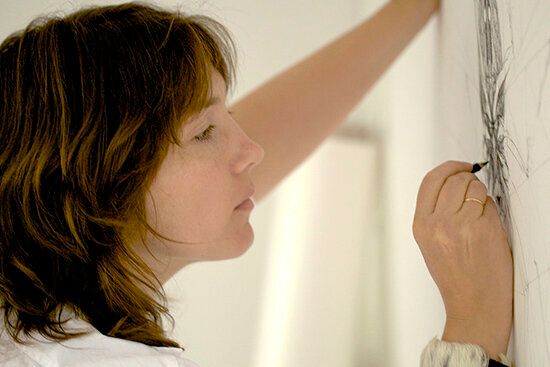
Artists who don't conform - the Goyas, the Van Goghs, the Hogarths - are a fascinating bunch to me. It's as if they came from somewhere beyond the other artists of their time. Like birds who migrate in an opposite direction. What makes them special? One day we'll be informed: an expert somewhere will crack the code and we'll learn immediately through something like Twitter. But until that sorrowful time, let's continue to enjoy their uniqueness and be happy that Jessica Albarn is as unclassifiable as she is.
Everything about the artist Jessica Albarn is wonderfully different. While her clean fine lines show her instinctive empathy with nature, her life's work has given her insight that few possess about the subject of death. Allergic to celebrity (even though Damon Albarn, former Blur frontman and the creator behind the virtual band Gorillaz, is her brother), she has kept herself privately busy while capturing her beliefs on paper. Her serious skills as a draughtsman are unmissable in the tiny details of her subjects - mostly insects and especially bees - which she has chosen to collect.
Allergic also to the art clique culture, in which conventional artists are forced to operate, she believes that she is one of those artists, who can't fit into that comfortable thing where people like to box things. "I've fallen in-between worlds even though I did a fine art degree at Hornsey school of art (now Middlesex university) and that's how I see my way of thinking. In my Phd year I had my first child and my artistic career path has not been a conventional one." Thus she has chosen to collaborate with renowned curator Andy Phipps whose expertise lies in creating a wholly original experience for an art audience. He has helped find a temporary residence for her distinctive works -with a touch not unlike Leonardo da Vinci's - at The Crypt of St. John the Baptist's in Bristol. The show will then move to London in July.

Phipps explains his choice of venue "If you haven't been there, The Crypt of St. John the Baptist's in Bristol is a spooky place where the connotation of death dwells. From the outside it looks like every other place, but this ordinary exterior hides an eerie an extraordinary interior, with Jessica Albarn's work in it, all displayed in the murky twilight, it encourages one to imagine things. It is a brilliant use of this space that would otherwise lay dormant."

So what sparked Jessica Albarn's fascination with death? Born in London, like endless British roadworks, the little Albarns were dug up and relocated to the environs of Aldham in Essex. There, with new surrounds, their imaginations thrived with the constant freedom and the little Albarns inhabited a "magical" world. Perhaps that's why both Jessica and Damon's art and music is so varied, accomplished and imaginative. "My parents were both artists. My mum grew up on a farm and she had immense freedom so she was very relaxed with Damon and I. We spent our childhood running around in the wood, finding birds and hedgehogs and I could go out all day and go down to the river and build hide-outs in the trees and my mum let us go which I think nowadays not a lot of children get."

In England, in the 70s, there wasn't a natural hunger for escapist nonsenses and the Albarn parents were a betrayal of their own era. "My father was an architect and a conscientious objector in the war. He came from a very intellectual family. We had a rich family background to draw from. My mum rode horses where she grew up on a farm and when our neighbour who owned a pub in Essex bought some horses, they were untrained and he had no idea what to do with them so he asked my mum for her guidance. So we learned to ride in a very natural way, it was just about getting on your horse and just galloping around the field, not going to dressage or show-jumping or wearing hair nets. We'd see people trotting along with their hair-nets and that's not what we were about at all."
Jessica, born into the vortex of change that was the British 70s, never had a second to be consumed by restrictive technological modernity. "Damon was musical. He had a natural ability. We'd have piano lessons indoors and he was great, but the minute they were over, I'd immediately escape outdoors as fast as I could to hang about with animals. I had a lot of animals right from an early age. I rode horses, bred guinea pigs, cats, rabbits, and looked after strays. I believe that this outdoor freedom gave us a great artistic start."
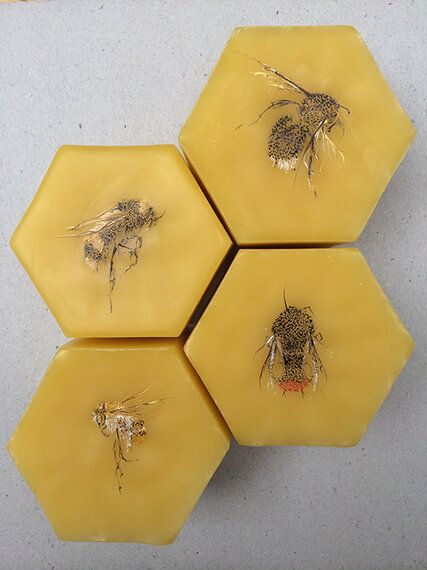
While her drawings on paper are merely brilliant, Jessica Albarn's works on wax, clay and glass are different to the point of being otherworldly. It's hard to think of another artist whose work seems as self-evidently progressive and ahead of her times as this. Goya perhaps, certainly da Vinci. Albarn is not quite as painterly in her execution - but as an artist she shares their fearlessness and their darkness. Interested in the dark workings of death, she certainly qualifies to join these names as she has made the mind's basement her preferred terrain.
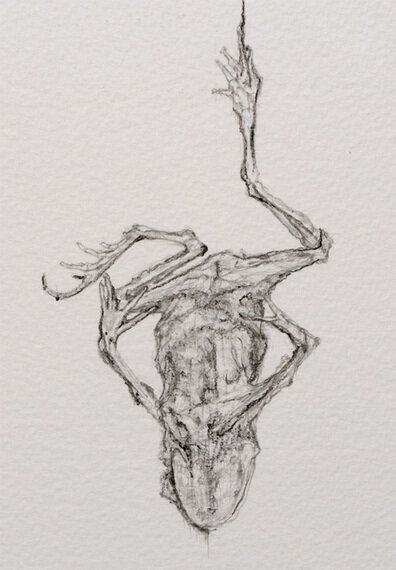
Anyone who has encountered her books might guess that she works from a Roald Dahl-ish shed at the end of her garden. But in Albarn's shed dead things loom around you as her shelves are littered with dead birds, insects and hundreds of bees. Plus like Goya, Albern's fascination with little dead things started early. "There's a piece in the show called "Box of Treasures" - drawings of specimens I collected in childhood.

There's also an Elizabethan mouse that my dad found when he opened up a priest hole in the wall when we were kids. The house Damon and I grew up in dated back in parts to the 14th century."
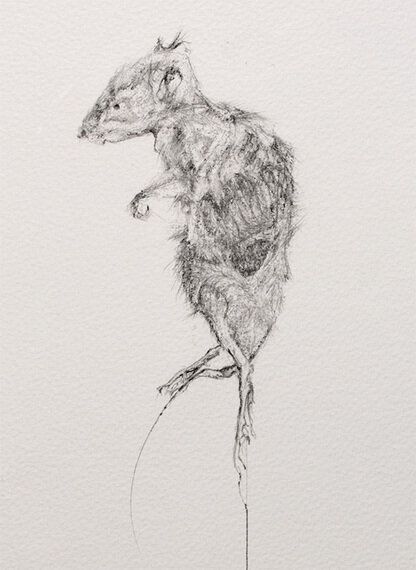
Yet another specie's death is made utterly explicit in the show. "When my own kids were very small, we had four rabbits. I would let them run about our garden in London all day and then shepherd them each night into their hutch. One morning I had a sixth sense that something was wrong and when I came down into our extension that opens onto the garden, I didn't ping back the blind like I usually do. My kids thankfully, were spared the sight of the garden, it was like a scene from a horror film. A fox had come in the night and killed all four." Albarn took the bodies to her studio and created the piece 'Memorial'.
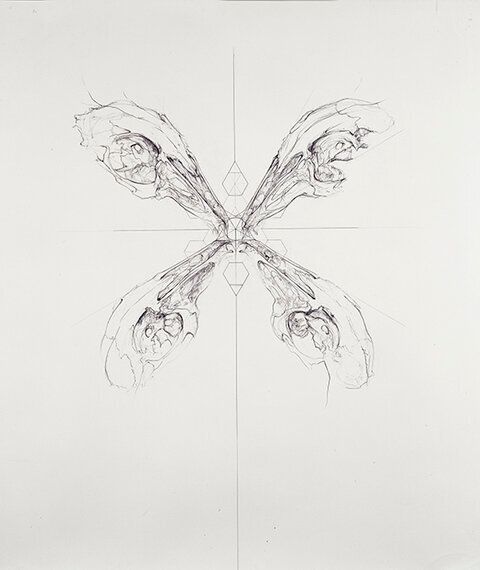
"I think that I'm particularly attuned to death, but it's a type intimate relationship isn't it that you have within yourself? I have in my studio a large collection of dead insects locally that I've collected, but also a lot of bones and all sorts of things which begin like a starting point for a piece of work. Plus, I have an obsessive collection of bees, which I draw. I've got many now. I believe that maybe it's a way of collecting weird beauty, of analysing the dead form and drawing out some form of beauty form it. To draw out what's left."
In fact her particular of interest is the bee. "Funnily enough, when I worked with The Natural History museum recently, I went into their collections and I wanted to document the 60 species of British bees which I have worked with for this exhibition. There were very low numbers of honeybees. They're not very well documented funnily enough." It seemed like a gargantuan amount of research? "I've been collecting bee specimens since childhood. My constant research is a nod to the industriousness of bees. I've also done drawing performances before where I sold drawings and donated the money to the Bumblebee Conservation Trust. It's been important to me from the beginning to give something back."
I vaguely imagined that my knowledge of China's bee population and the pesticides used in pear orchards there, which wiped out bees in parts of Sichuan in the 1980s would take me closer to appreciating Jessica Albarn's subject. Or the fact that crops are now pollinated by hand in parts of Sichuan, using feather brushes, a time consuming replacement process, as one tiny colony of bees can pollinate up to 300m flowers a day.
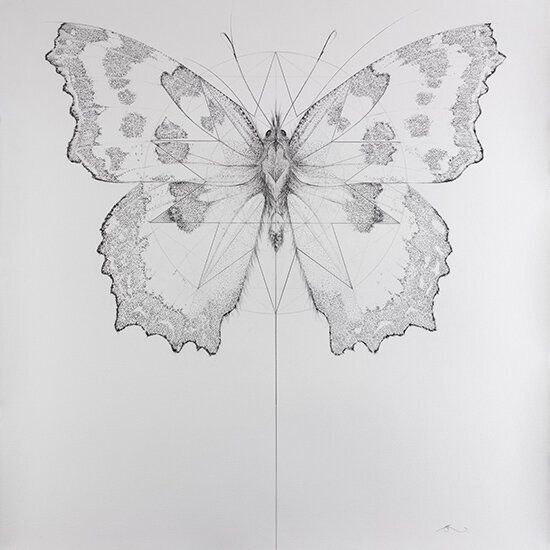
"My portraiture tries to rescues each bee, butterfly, frog or bird from its natural oblivion and gives it a tangible individual personality" she explains. Although dead she treats them as individuals and portrays them as if they were alive. A portrait of a large Tortoiseshell butterfly is particularly lifelike. Freudians may wish to analyse at length such a morbid fascination, but I am content to enjoy the breath taking visual artistic technique that captures that moment of transformation. I wondered what sparked her deep interest in death?
"I had pneumonia as a child and experienced strange hallucinations. I remember that there were varying hallucinations while I had fever. The most vivid was when I thought I was a very fine pole of thin glass and I was teetering on my wooden bedroom floor. They stayed with me, particularly through my adolescence and I've explored them. It's this physical sensation I felt, which is embodied in the work in this show. Recently, I read a poem by John Donne and it kind of really hit me and everything then made sense. It's called Till us death lay and it's lines are...
Till Us Death Lay
to ripe mellow here,
we are stubborn clay.
Parents make us earth,
and souls dignify.
Us to be glass;
here to grow gold we lie.
John Donne 1572-1631

From start to finish, I'm on the same page as Jessica Albarn, as her work, like many great artists, tries to attempt unusual things. Haven't we all had hallucinations of large birds in childhood fevers? Or is it just me? I put my particular brand of understanding down to the a similar fever and the Irish gene. And without hesitation Albarn responds that it might be the Irish in her that sparks such creative freedom, "I have Irish blood in me and have always identified with the Irish and Icelandic form of storytelling. There's a storytelling gene, which I think the Irish have. That gift of special storytelling is so fruitful to be around. I've also found it in Iceland, it's why Damon bought a house there."
Telling her story without the introduction of wax, glass or clay, would be a brilliant piece of social observation on paper. With the four other mediums, it enlarges into a show that's a close first cousin to an artistic version of Al Gore's film An Inconvenient Truth. The bold simple outline of her bees and insects on glass, canvas, wax and clay, seems to somehow highlight the industriousness of each insect within the four elements that spells out humanity's lot. Albern explains, "Albert Einstein famously said that ""if the bee disappeared off the surface of the globe, man would have only four years to live."
That's the thing about Jessica Albarn. It doesn't matter if it's a mouse, a bee or a butterfly: examined in depth by her, their (our) vulnerability becomes a fascinating experience.
Jessica Albarn - Resurrection at The Crypt of St John the Baptist
18 - 27 April 2014
An exhibition of new works on glass, paper, wax, canvas and clay
Live Drawing: 20th April
The Crypt of St John the Baptist, Quay Street, Bristol, BS1 2EZ
10am - 6pm www.jessicaalbarn.co.uk